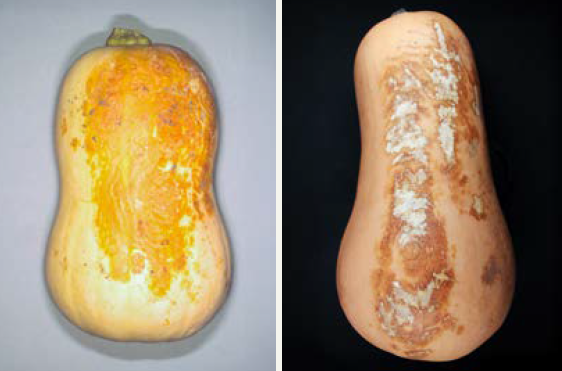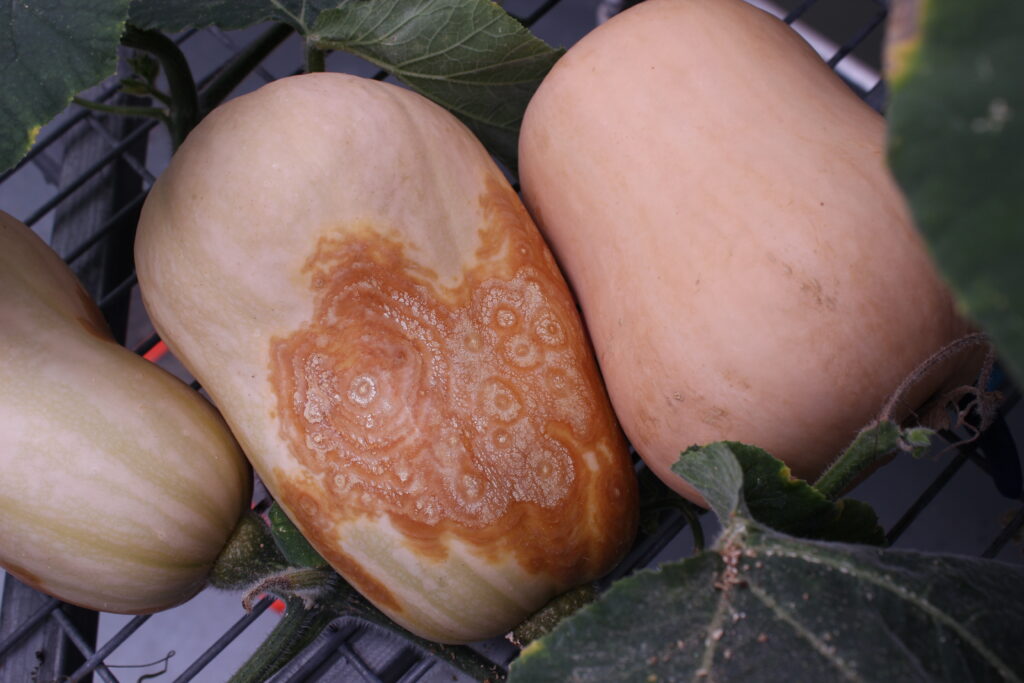Robotic yield projection in Bundaberg eggplants
28 May 2025
Recapturing water and nutrients on WA’s deep sands
28 May 2025By Marlo Marlinaro, PhD Candidate, La Trobe University
Brown etch is a mysterious condition affecting pumpkin growers in Australia. While it only impacts the outer skin of the fruit, its presence reduces market value and causes significant economic losses (Figure 1).
What makes brown etch particularly frustrating is that, despite years of research, its cause remains unknown. Unlike diseases caused by Stagonosporopsis cucurbitacearum (gummy stem and black fruit rot), brown etch doesn’t damage the fruit’s inner tissues. This subtlety has led to confusion in diagnosis and makes management challenging.
With no clear culprit, growers often rely on preventive measures like careful handling and reducing field time to limit brown etch, but these strategies only offer partial relief. Fungicides and postharvest storage adjustments have shown limited success.
The lack of an identifiable pathogen or environmental trigger leaves scientists with few clues. This highlights a broader issue in plant pathology: many emerging disorders defy easy explanation, especially when they don’t follow clear patterns of pathogen transmission or host response.
New tools are giving researchers hope, however. Molecular techniques such as DNA and RNA sequencing, along with advanced microscopy, are helping to explore potential links between microbes, the environment, and plant health.
Metagenomics, in particular, is proving valuable. By studying the microbial communities living on and around the pumpkin, scientists may uncover hidden interactions that contribute to brown etch. Understanding these microbial ecosystems could eventually lead to effective management strategies.
Beyond immediate field applications, solving the mystery of brown etch holds broader significance. Any insights gained will expand the genetic resources available to pumpkin breeders, helping them select for resistance to this disorder and other pests and diseases. For an industry built on tight margins and consumer expectations for blemish-free produce, these advances could be game-changing.
A closer look at brown etch symptoms

L-R. Figure 2. Stagonosporopsis cucurbitacearum, ©Marlo Molinaro. Brown etch, ©Claire Fecteau, Laboratory of Expertise and Diagnosis in Plant Protection (MAPAQ). The symptoms of these conditions show high similarity
Brown etch manifests as superficial brown markings on the pumpkin’s skin. These blemishes don’t penetrate the inner flesh, which is why brown etch is often confused with diseases caused by fungal pathogens like S. cucurbitacearum or Fusarium spp.
While similar in appearance, however, the two issues behave differently. S. cucurbitacearum typically invades deeper tissues and can lead to fruit rot, whereas brown etch remains confined
the surface (Figure 2).
The visual similarity to fungal infections can mislead even experienced growers, causing them to apply fungicides unnecessarily or make premature decisions about fruit quality. This confusion complicates both diagnosis and management, further frustrating efforts to control the disorder.
To date, no environmental factor or pathogen has been consistently linked to brown etch. Variables such as humidity, temperature, or mechanical damage have been studied, but none provide a definitive answer. This points to a complex interaction of potential factors, reinforcing the need for advanced investigative approaches.
Exploring possible causes
Researchers suspect that brown etch might not have a single cause, but rather result from a combination of environmental stresses, plant defence mechanisms, insect, and microbial interactions (Figure 3).

Figure 3. Butternut pumpkin grown in temperature-controlled glasshouse with brown etch. Each centre point is potentially a separate starting site. ©Marlo Molinaro.
Environmental triggers like fluctuating humidity, extreme temperatures, or mechanical damage during handling could weaken the fruit’s defences. This may open the door for opportunistic microbes to colonise the surface, leading to the visible symptoms of brown etch. Which may set off a defence response within the pumpkin that does not stop with the initial symptoms.
Modern technologies are opening new paths for understanding these complex dynamics. High-throughout DNA sequencing allows scientists to study the entire microbial community on the fruit’s surface, identifying bacteria, fungi, and viruses that might play a role. By comparing healthy and affected pumpkins, researchers can spot differences in microbial populations that could explain the onset of symptoms.
Advanced imaging techniques, including electron microscopy, can also reveal structural changes in the fruit’s skin at a microscopic level. Scanning electron microscopy has shown a difference between unaffected and etched skin for both surface (Figure 4) and cross section samples of butternut pumpkin (Figure 5).
The surface on unaffected pumpkins shows a smooth surface, while the etched pumpkin surface has cuticle damage and a rough appearance of unknown substance. The cross section shows a degradation of the cuticle layer (surface) and a collapse of cells between the skin and fruit layers. Combined with molecular data, this can help piece together the puzzle of how brown etch develops.
 The road ahead: solutions for growers
The road ahead: solutions for growers
For growers, the uncertainty surrounding brown etch makes decision-making difficult. Without a clear cause, management of the problem must focus on risk reduction rather than targeted treatments. Gentle handling, minimising field time, and prompt cooling after harvest remain the best practices, even though they don’t guarantee full protection.
Research into breeding pumpkin varieties with tougher skin or improved resistance to environmental stresses offers promise. Advances in genetic studies and molecular breeding
techniques could one day enable the development of cultivars less susceptible to brown etch.
Industry collaboration will also play a vital role. Sharing data and insights between researchers, growers, and industry bodies can accelerate progress. Initiatives that combine traditional horticultural knowledge with cutting-edge science will be key to finding answers.
Ultimately, solving the brown etch mystery is about more than just protecting pumpkins — it’s about strengthening Australia’s position as a reliable supplier of high-quality horticultural products. By investing in research and embracing new technologies, the industry can safeguard its future and continue to thrive.

